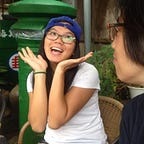03/04 Generative Research Synthesis
After a team lunch with Chinese takeout, we got down to the business of synthesizing what we learned from our research workshops so far (with Duolingo, two professors, and five language learners). We began by posting all of their ideas as well as a few of our own on a whiteboard.
Next, we organized these ideas by the themes that emerged (in order of density):
- Immersive space
- Conversational assistant/dialogue practice
- Contextual prompts (while in a new culture/new linguistic landscape)
- Translators
- Social learning (learn language and culture in groups)
- Feedback
- Secondary exposure to the language
- Vocabulary
- Assistant for non-verbal behaviors
- Formal learning
From there, Ashlesha and I brought in some of what we’ve learned from Stacie’s Learner Experience Design course. We took the opportunity spaces from our bucket titles and mapped them first to a circular learning cycle and then to a hilly journey.
Because our target context is intermediate to advanced learners who already have an introduction to the language, we want our solution to focus not on formal learning (vocabulary, translation, traditional classroom reading/writing/speaking/listening) but on the exposure to the language and culture and on the application of what is learned.
We began to map the learning cycle onto the hilly journey on the left based on the idea that throughout the learning cycle, learners need both to be challenged (bike up the hill) and feel confident (coasting down). We thought about which components might provide more of a challenge, like practicing vocabulary and dialogues in immersive spaces, and which might be more of a confidence-booster like passively listening or observing.
From these maps, we were able to extract three concept spaces:
- Passive Exposure: Everyday Life + Language
- Immersive Virtual Environment
- Once abroad, help learners apply what they’ve learned to appropriate contexts
We rearranged our initial idea post-its to map to these three spaces.
Passive Exposure: Everyday Life + Language
We heard that successful language learners start early and surround themselves with this second language and culture. Since we’ve chosen to focus on designing for intermediate or advanced learners with a variety of backgrounds, it may not have been possible for these learners to be exposed to the sounds and environments of this secondary culture from an early age–but can we introduce them now? Being surrounded by these sounds, words, and environments can help learners with their pronunciation and application of the language, allowing their entrance into a new linguistic landscape to be a little less stressful.
Immersive Virtual Environment
This is the biggest component of language learning that traditional language learning lacks. Both of the professors we spoke to built a virtual environment with the cards and props we provided. A virtual environment can help students locate themselves and their confidence within a low-stakes environment before heading out into the real world for language and cultural learning and application. Virtual environments can also shift easily, so for example, if you’re learning French you can visit both a hospital in France and a hospital in Senegal.
Once Abroad, Help Learners Apply What They’ve Learned to Appropriate Contexts
Our learners who either are currently in a secondary language culture or have been immersed in one came up with some ideas about prompting learners with appropriate dialogues, vocabulary, etiquette, and more. While they may have learned component skills in a limited immersion space, applying those skills is a different way of thinking that might benefit from nudging.
We hope to get feedback from the class and from our Microsoft liaisons about a direction to head in, and we’ll move forward by testing concepts and creating low-fidelity prototypes with our participants.
